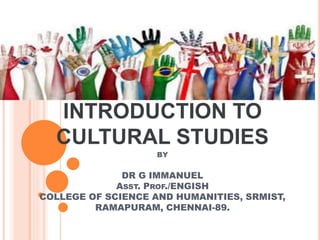
INTRODUCTION TO CULTURAL STUDIES (2).ppt
- 1. INTRODUCTION TO CULTURAL STUDIES BY DR G IMMANUEL ASST. PROF./ENGISH COLLEGE OF SCIENCE AND HUMANITIES, SRMIST, RAMAPURAM, CHENNAI-89.
- 2. CULTURE Culture is the characteristics and knowledge of a particular group of people, encompassing language, religion, cuisine, social habits, music and arts. ... The word "culture" derives from a French term, which in turn derives from the Latin "colere," which means to tend to the earth and grow, or cultivation and nurture.
- 3. DEFINITION OF CULTURE Culture refers to the cumulative deposit of knowledge, experience, beliefs, values, attitudes, meanings, hierarchies, religion, notions of time, roles, spatial relations, concepts of the universe, and material objects and possessions acquired by a group of people in the course of generations through individual and group striving. Culture is the systems of knowledge shared by a relatively large group of people. Culture is communication, communication is culture.
- 4. DEFINITION… Culture in its broadest sense is cultivated behavior; that is the totality of a person's learned, accumulated experience which is socially transmitted, or more briefly, behavior through social learning. A culture is a way of life of a group of people--the behaviors, beliefs, values, and symbols that they accept, generally without thinking about them, and that are passed along by communication and imitation from one generation to the next.
- 5. DEFINITION… Culture is symbolic communication. Some of its symbols include a group's skills, knowledge, attitudes, values, and motives. The meanings of the symbols are learned and deliberately perpetuated in a society through its institutions. Culture consists of patterns, explicit and implicit, of and for behavior acquired and transmitted by symbols, constituting the distinctive achievement of human groups, including their embodiments in artifacts; the essential core of culture consists of traditional ideas and especially their attached values; culture systems may, on the one hand, be considered as products of action, on the other hand, as conditioning influences upon further action.
- 6. DEFINITION… Culture is the sum of total of the learned behavior of a group of people that are generally considered to be the tradition of that people and are transmitted from generation to generation. Culture is a collective programming of the mind that distinguishes the members of one group or category of people from another.
- 8. Cultural differences manifest themselves in different ways and differing levels of depth. Symbols represent the most superficial and values the deepest manifestations of culture, with heroes and rituals in between. Symbols are words, gestures, pictures, or objects that carry a particular meaning which is only recognized by those who share a particular culture. New symbols easily develop, old ones disappear. Symbols from one particular group are regularly copied by others. This is why symbols represent the outermost layer of a culture.
- 9. Heroes are persons, past or present, real or fictitious, who possess characteristics that are highly prized in a culture. They also serve as models for behavior. Rituals are collective activities, sometimes superfluous in reaching desired objectives, but are considered as socially essential. They are therefore carried out most of the times for their own sake (ways of greetings, paying respect to others, religious and social ceremonies, etc.).
- 10. The core of a culture is formed by values. They are broad tendencies for preferences of certain state of affairs to others (good- evil, right-wrong, natural-unnatural). Many values remain unconscious to those who hold them. Therefore they often cannot be discussed, nor they can be directly observed by others. Values can only be inferred from the way people act under different circumstances. Symbols, heroes, and rituals are the tangible or visual aspects of the practices of a culture. The true cultural meaning of the practices is intangible; this is revealed only when the practices are interpreted by the insiders.
- 11. LAYERS OF CULTURE People even within the same culture carry several layers of mental programming within themselves. Different layers of culture exist at the following levels: The National Level The Regional Level The Gender Level The Generation Level The Social Class Level The Corporate Level
- 12. LAYERS OF CULTURE THE NATIONAL LEVEL: Associated with the nation as a whole. THE REGIONAL LEVEL: Associated with ethnic, linguistic, or religious differences that exist within a nation. THE GENDER LEVEL: Associated with gender differences (female vs. male) THE GENERATION LEVEL: Associated with the differences between grandparents and parents, parents and children. THE SOCIAL CLASS LEVEL: Associated with educational opportunities and differences in occupation. THE CORPORATE LEVEL: Associated with the particular culture of an organization. Applicable to those who are employed.
- 13. MEASURING CULTURAL DIFFERENCES Power distance index: The index measures the degree of inequality that exists in a society. Uncertainty avoidance index: The index measures the extent to which a society feels threatened by uncertain or ambiguous situations. Individualism index: The index measure the extent to which a society is individualistic. Individualism refers to a loosely knit social framework in a society in which people are supposed to take care of themselves and their immediate families only. The other end of the spectrum would be collectivism that occurs when there is a tight social framework in which people distinguish between in-groups and out-groups; they expect their in- groups (relatives, clans, organizations) to look after them in exchange for absolute loyalty.
- 14. MEASURING CULTURAL DIFFERENCES Masculinity index (Achievement vs. Relationship): The index measures the extent to which the dominant values are assertiveness, money and things (achievement), not caring for others or for quality of life. The other end of the spectrum would be femininity (relationship).